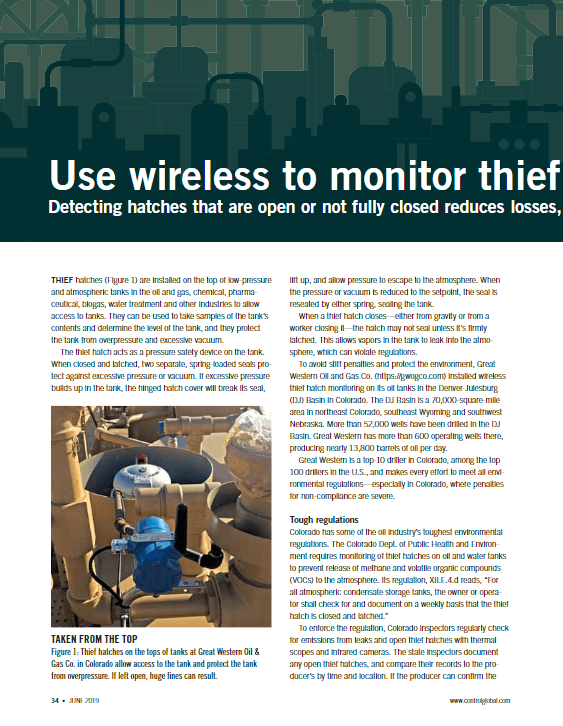 I shared a great case study from the oil patch yesterday with time savings with wireless pressure monitoring at the well head. Today, let’s continue with another great case study from the oil patch with a Control magazine article, Use wireless to monitor thief hatches.
I shared a great case study from the oil patch yesterday with time savings with wireless pressure monitoring at the well head. Today, let’s continue with another great case study from the oil patch with a Control magazine article, Use wireless to monitor thief hatches.
The article’s author opens describing what a thief hatch is. These devices are:
…installed on the top of low-pressure and atmospheric tanks in the oil & gas, chemical, pharmaceutical, biogas, water treatment and other industries to allow access to the tank. They can be used to take samples of the tank’s contents and determine the level of the tank, and they protect the tank from overpressure and excessive vacuum.
When an overpressure or excessive vacuum event occurs:
…the hinged hatch cover will break its seal, lift and allow the pressure to escape to the atmosphere. When the pressure or vacuum is reduced to the setpoint, the seal is reseated by either spring, sealing the tank.
The challenge which may lead to regulatory fines?
When a thief hatch closes—either from gravity or from a worker closing it—the hatch may not seal unless it is firmly latched. This allows vapors in the tank to leak into the atmosphere, which can violate regulations.
For the oil & gas producer operating in the U.S. State of Colorado, the regulations require:
…monitoring of thief hatches on oil and water tanks to prevent release of methane and volatile organic compounds (VOCs) to the atmosphere.
State inspectors:
…document any open thief hatches, and compare their records to the producer’s by time and location. If the producer can confirm the thief hatch was open—perhaps for maintenance or sampling—at the same time as the inspector found it open, then there’s no problem and no penalty. If the producer cannot confirm from its records as to why the hatch was open, penalties and fines are assessed.
Here was the solution this oil & gas producer used to monitor their thief hatches [hyperlink added by me]:
Rosemount 702 discrete WirelessHART transmitters…can be installed on existing thief hatches and tank batteries to effectively ensure the hatches are closed and latched. The concept is fairly simple: A switch at the latch…detects when the latch is closed.
Read the article for more on the inner workings of the thief hatch and switch monitoring for proper closing as well as the wireless architecture applied, and the business results achieved by fine avoidance. It’s yet another example of using Industrial Internet of Things sensing technologies to improve business performance.
Visit the Industrial Wireless Technology and Tank Vents and Hatches sections on Emerson.com for more on the application of these technologies. You can also connect and interact with wireless sensor and tank vent/hatches experts in the IIoT & Digital Transformation and Valves, Actuators & Regulators groups in the Emerson Exchange 365 community and/or at the September 23-27 Emerson Exchange conference in Nashville.




